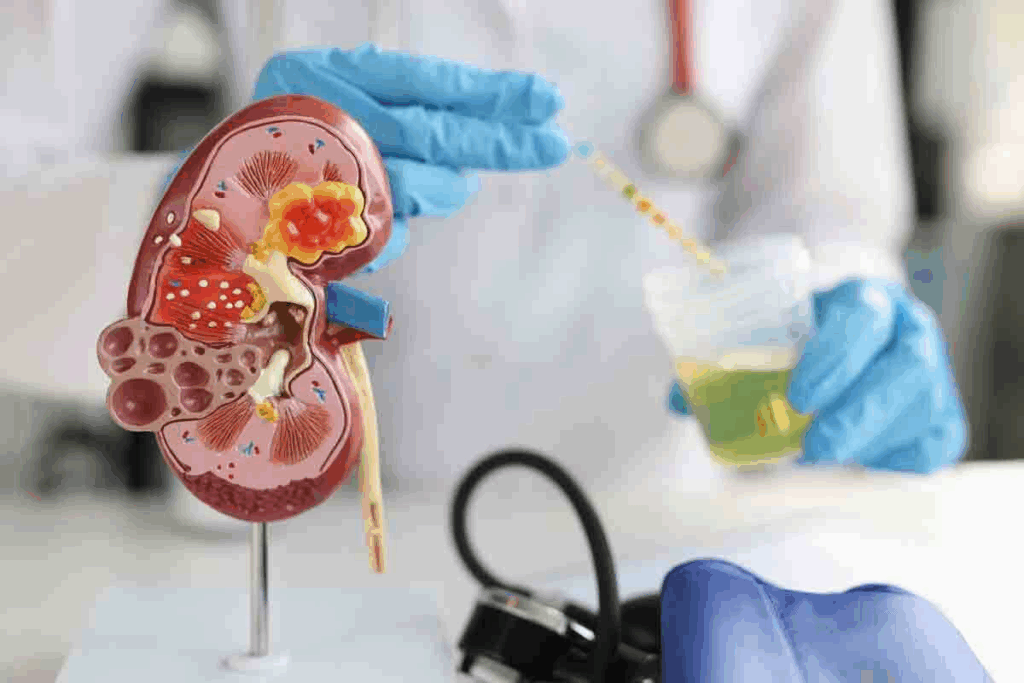
An Intravenous Pyelogram (IVP) is a special X-ray test. It shows the urinary tract, like the kidneys, ureters, and bladder. It’s key for spotting problems in the urinary system.
When you get an IVP, an iodine-based contrast dye is given through an IV. This lets doctors see how the urinary tract works. It’s an advanced diagnostic technique for finding and fixing urinary tract issues.
At Liv Hospital, we use IVP tests in our detailed diagnostic services. We make sure patients get the right diagnosis for the best treatment plans.

The Intravenous Pyelogram (IVP) is a way to see the urinary system through medical imaging. It helps doctors find and confirm many urinary tract diseases.
To define IVP, it’s an X-ray test that uses dye to show the kidneys, ureters, and bladder. Its main goal is to spot problems like blockages, stones, and tumors in the urinary tract.
IVP, or Intravenous Pyelogram, means injecting dye into a vein. This dye is then passed through the urine. X-rays are taken at set times to see how the dye moves through the system.
This helps doctors understand the kidneys, ureters, and bladder’s structure and function. The main aim of IVP is to get clear images for diagnosing urinary tract issues. Doctors say IVP is very useful, even with newer imaging methods, because it gives a full view of the urinary system.
“The intravenous pyelogram is a time-honored diagnostic modality that has been used for decades to evaluate the urinary tract.”
Kidney imaging started in the early 20th century with the first IVP. Over time, X-ray tech and dye have improved a lot.
| Year | Development |
| 1920s | Introduction of IVP |
| 1950s | Advancements in X-ray technology |
| 1980s | Development of newer contrast media |
Newer tests like ultrasound and CT scans are common now. But IVP is also important because of its unique benefits. Its history shows it’s a reliable tool for diagnosis.
In conclusion, knowing about IVP helps us see its importance in finding urinary tract problems. By looking at its history and uses today, we understand its value.

The IVP test uses a contrast dye injected into a vein. This dye helps show the urinary system in detail. It’s key for seeing the kidneys, ureters, and bladder.
IVP dye, or contrast media, makes the urinary tract visible during the test. The dye is injected through a vein, usually in the arm. It then goes to the kidneys through the bloodstream.
“The contrast dye is safe and works well. It gives clear images of the urinary system without harming the patient.”
After reaching the kidneys, the dye is filtered out and becomes more concentrated in the urine. This makes the kidneys, ureters, and bladder stand out in X-ray images.
This method, called pyelography, lets doctors see how the urinary system works. The images help find problems like blockages or tumors in the kidneys, ureters, or bladder.
IVP dye is a key part of the IVP test. It helps doctors diagnose and keep track of urinary tract issues. Knowing how IVP dye works and the pyelogram imaging process helps patients understand its importance.
IVP testing helps find many medical issues with the kidneys and urinary system. It’s key for spotting problems and figuring out the right treatment.
IVP testing is great for finding kidney stones and blockages in the urinary tract. These issues can hurt a lot and cause bigger problems if not treated quickly.
Kidney stones are hard mineral clumps in the kidneys. IVP shows where and how big these stones are. This info is vital for treatment plans.
| Condition | Symptoms | IVP Findings |
| Kidney Stones | Severe pain, nausea, vomiting | Visible stones, obstruction |
| Urinary Tract Obstruction | Pain, difficulty urinating | Dilation of the urinary tract |
IVP testing also spots tumors and odd shapes in the urinary system. Tumors might need more tests, like biopsies, to see if they’re cancerous.
Things like duplex kidneys or horseshoe kidneys can be found with IVP. Even if they don’t cause symptoms, they can lead to problems like infections or stones.
IVP testing can also find kidney problems that kids are born with. These issues might affect how the kidneys look or work, or the urinary tract.
Finding these problems early helps manage them better. It can also stop long-term kidney damage.
Before your IVP test, you must follow certain steps to stay safe and get the best results. We’re here to help you prepare every step of the way.
To get ready for your IVP test, there are important steps to take. Tell your doctor about all medications, including supplements and vitamins, as some might need to be changed or stopped. Also, remember to:
As a medical expert says, “Proper preparation is key for a successful IVP test.”
“Patients who prepare well have a smoother and more successful procedure,” says a well-known radiologist.
Before your IVP test, you might need to change your diet. You might have to fast or avoid certain foods and drinks before the test. Your doctor might also ask you to take a laxative the night before to help clear your bowels. This improves the quality of the images during the IVP.
It’s also vital to follow any medication advice from your healthcare provider. Some medications might need to be skipped before the test to avoid any issues with the contrast dye used in the IVP. We’ll give you all the details on managing your medications before the test.
By following these guidelines, you can help make sure your IVP test is safe and effective. This will give your healthcare team the information they need to make an accurate diagnosis.
Getting ready for your IVP exam? It’s good to know what’s coming. The IVP checks how your kidneys work and finds any problems.
You’ll get instructions on how to prepare before your IVP. You might need to avoid certain foods or drinks. Also, tell us about any medicines you’re taking.
Getting ready is key to good IVP results. Our team will help you get ready so you’re comfortable and ready to go.
For the IVP, you’ll lie on an X-ray table. An X-ray machine will be over your belly. Then, a dye will be given through an IV in your arm.
The dye makes your urinary tract show up on X-rays. This helps us find issues like kidney stones or tumors.
After the IVP, you might feel a warm feeling or taste something metallic. These feelings usually go away quickly.
We’ll give you post-procedure care instructions. Drinking lots of water helps get rid of the dye. You can usually go back to normal activities soon after.
Our team is here to answer any questions. We’ll also talk about any extra tests or follow-ups you might need.
An IVP uses iodine-based dye to show the urinary system’s structures. This dye is key for seeing the kidneys, ureters, and bladder. The IVP needs to work right.
The dye in IVPs is mostly iodinated compounds. These compounds have iodine, which absorbs X-rays. This makes the urinary tract visible during the IVP.
Iodine-based dye is safe for most people. But it’s important to tell doctors about any iodine allergies or past reactions to dyes.
After being given, the dye goes through the blood and is filtered by the kidneys. It then moves into the urine. The urine, with the dye, goes through the ureters and into the bladder.
The dye’s journey helps doctors see how well the kidneys are working. It also helps find problems like kidney stones or tumors. This is because the dye’s flow shows up in X-ray images.
Knowing how the dye moves is key to understanding IVP results. This helps doctors spot problems and decide on the next steps.
IVP is a key tool for doctors to diagnose issues. But it’s important to know the risks and side effects. This knowledge helps patients decide if IVP is right for them.
Most people do well with IVP testing. But, some might feel warmth, taste metal, get nauseous, itch, or break out in hives. These effects are usually mild and go away quickly after the test.
Here’s a look at how common these reactions are:
| Common Reaction | Frequency |
| Feeling of warmth or flushing | 15-20% |
| Metallic taste | 10-15% |
| Nausea | 5-10% |
| Itching or hives | 2-5% |
Some people might have an allergic reaction to the dye used in IVP. These reactions can be mild or serious. It’s key to tell your doctor about any allergies or past reactions to dye. Signs of an allergic reaction include trouble breathing, a fast heart rate, or low blood pressure. If you notice these, get help right away.
IVP isn’t right for everyone. It’s not for those with severe kidney disease, pregnant women, or people with severe dye allergies. Diabetics or those on certain meds like metformin might need to wait or take extra steps. Talk to your doctor about your health and any worries before the test.
Knowing the risks and side effects of IVP helps patients make smart choices. Always talk to a healthcare expert to get the best care.
CT pyelogram and CT IVP are big steps forward in urology. They offer better ways to see inside the body. These new methods help doctors find and fix problems in the urinary system.
A CT Intravenous Pyelogram (CT IVP) uses CT scans and dye to see the urinary system clearly. This tool shows the kidneys, ureters, and bladder in detail. Doctors can spot problems and make accurate diagnoses.
To do a CT IVP, a dye is injected into a vein. It goes through the kidneys, ureters, and bladder. A CT scanner takes pictures as it moves. This gives doctors important information about these organs.
CT IVP has clearer images and more detail than the old methods. It helps doctors find and fix problems like tumors and stones better.
Doctors say CT IVP is a key tool for urinary tract issues. It gives a detailed look that old methods can’t match. This helps doctors plan better treatments for complex cases.
Some main benefits of CT IVP are:
There are many ways to check how well the kidneys work and their structure, aside from the usual Intravenous Pyelogram (IVP). We’ll look at these options. They are key in checking kidney health and finding problems early.
Ultrasound uses sound waves to create images of the kidneys and urinary tract. It’s great for finding stones, cysts, and tumors. Ultrasound is often the first choice for checking kidney problems because it’s safe and works well.
Ultrasound shows images in real-time. This lets doctors check how the kidneys work and the blood flow. It’s also safe for pregnant women and kids because it doesn’t use radiation.
MRI urography uses MRI to see the urinary tract. It gives detailed pictures of the kidneys, ureters, and bladder. This helps find tumors, blockages, and other issues.
MRI urography is great for those who can’t have CT scans or IVP because of allergies or other reasons. It’s a good choice for finding kidney problems without using harmful radiation.
Nuclear medicine uses tiny amounts of radioactive materials to diagnose and treat kidney diseases. It shows how well the kidneys filter and how blood flows.
Nuclear medicine is very helpful for complex kidney diseases, like in kidney transplants or severe damage. Tests like renal scintigraphy and MAG3 renography give important insights. They help doctors make better treatment plans.
Getting your IVP test results can feel overwhelming, but we’re here to help. A radiologist, a doctor who specializes in X-rays and imaging, will look at your results. They will send the report to your healthcare provider, who will talk to you about it.
IVP results can show if everything is okay or if there’s a problem. Normal results mean your kidneys, ureters, and bladder are working right. They found no blockages or issues.
Abnormal findings might mean kidney stones, tumors, or problems with the urinary tract.
Some common issues include:
| Finding | Possible Indication | Next Steps |
| Kidney Stone | Obstruction, pain | Further imaging, possible surgery |
| Tumor | Cancer or benign growth | Biopsy, more imaging |
| Structural Abnormality | Congenital issue | Monitoring, possible surgery |
If your IVP shows something abnormal, your doctor might suggest more tests. This could be more imaging, like a CT scan, or MRI, or a biopsy.
“The key to effective treatment lies in accurate diagnosis. Your IVP results are a critical step in understanding your kidney health.”
— Expert Opinion
We know getting your IVP results is a big moment. We’re here to support you, from understanding your results to any follow-up tests.
Medical imaging technology keeps getting better, changing how we use Intravenous Pyelogram (IVP) in nephrology. Even though newer tests are common, IVP is often a key tool. It’s useful in certain cases.
IVP helps doctors spot issues in the urinary system. It gives clear pictures of the kidneys, ureters, and bladder. This makes it great for finding problems like kidney stones and blockages.
The role of IVP in nephrology is changing. It’s now used more carefully, in specific situations. As we improve our diagnostic tools, IVP will stay an important part of nephrology.
An Intravenous Pyelogram (IVP) is a test that shows the kidneys, ureters, and bladder. It works by injecting dye into a vein. This dye is then passed by the kidneys, allowing for x-ray images.
The main goal of an IVP test is to find and track urinary tract problems. This includes kidney stones, tumors, and birth defects.
The IVP dye is injected into a vein and goes to the kidneys. There, it’s passed into the urine. This dye makes the urinary tract visible on X-rays.
Mild allergic reactions, like hives or itching, are common side effects. But severe reactions are rare. People with kidney disease or diabetes might face more risks.
To get ready for an IVP, you might need to fast or avoid certain medicines. You’ll also share your medical history. Your healthcare provider will give you specific instructions.
A CT IVP uses CT scans for better images of the urinary tract. It’s more detailed and often used for complex cases.
Other tests for kidney checks include ultrasound, MRI urography, and nuclear medicine studies. These might be used instead of or with IVP, depending on the case.
Only a healthcare expert should look at your IVP results. They’ll check for any issues like stones or tumors. Then, they’ll suggest further steps or treatment.
A CT pyelogram is a CT scan with contrast dye for the urinary tract. It helps find and track conditions like stones and tumors.
Yes, IVP testing is important in some medical situations, like urinary tract issues. Even with newer methods, IVP remains key for diagnosing and monitoring kidney and urinary tract problems.
Subscribe to our e-newsletter to stay informed about the latest innovations in the world of health and exclusive offers!
WhatsApp us